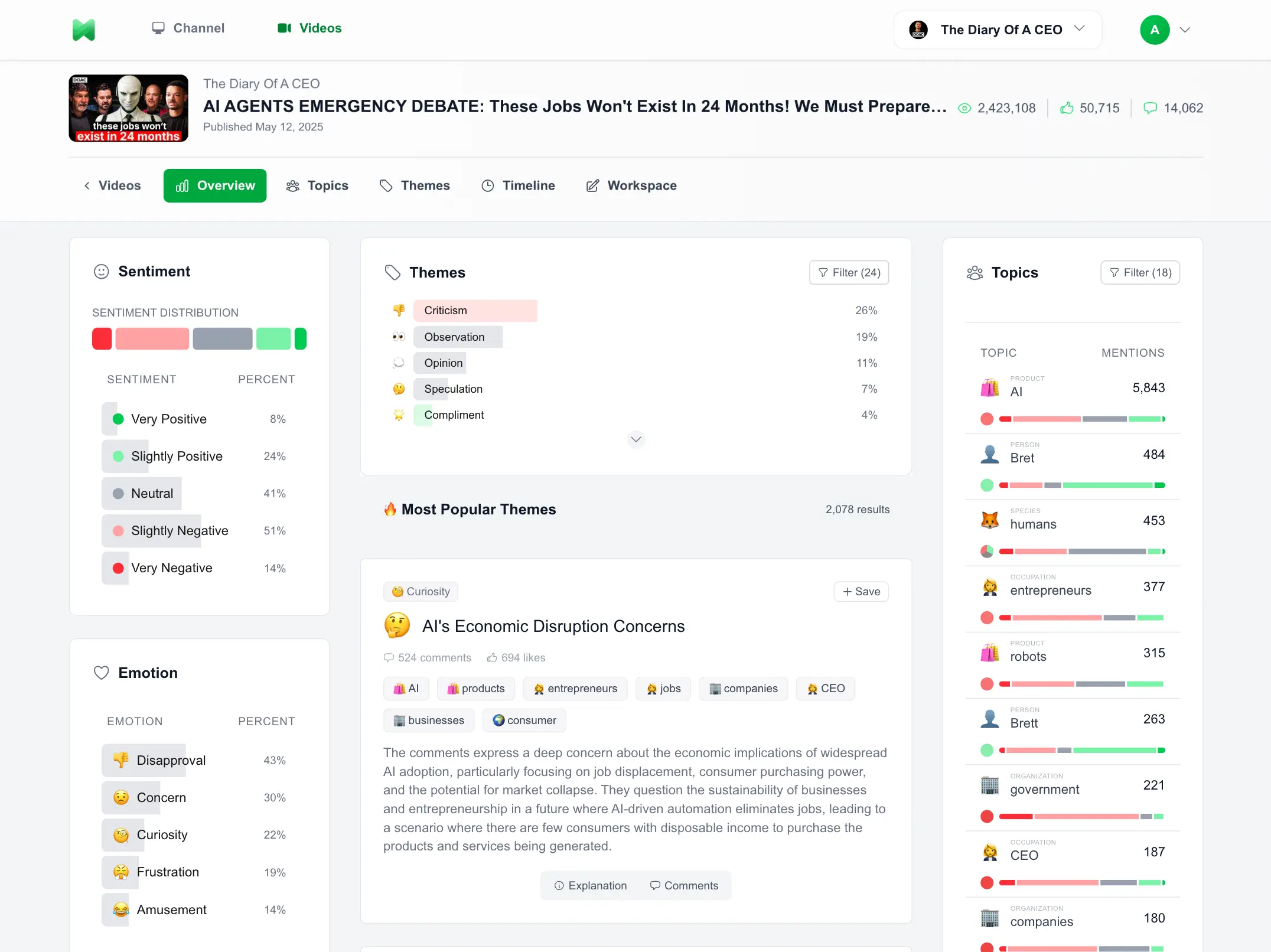Understanding Your Video Insights
Your video dashboard shows you exactly what your audience thinks and feels. Think of it as having a conversation with every viewer - Heckle listens to all their comments and organizes the feedback into clear, actionable insights you can actually use.

When you open a video in Heckle, you see your main dashboard. Think of this as your video's "report card" - it shows you everything important about how people reacted to your content.
What you'll see at a glance:
- • Overall mood: Is your audience mostly positive, negative, or neutral?
- • Top emotions: What feelings are your viewers experiencing most?
- • Popular topics: What subjects are people talking about in comments?
- • Common themes: Patterns in what viewers are saying
- • Timeline activity: When during your video people react most
Pro tip: Your dashboard updates in real-time as new comments come in. Check back periodically to see how reactions evolve, especially in the first 24-48 hours after publishing.
The sentiment panel shows you the overall "vibe" of your comments. It's like asking "Are people generally happy or unhappy with this video?" Heckle reads every comment and categorizes the feeling behind it.
The 5 sentiment levels:
Comments like "This is amazing!" or "Best tutorial ever!"
Comments like "Pretty good" or "Thanks for sharing"
Questions, factual statements, or neutral observations
Mild criticism or disappointment
Strong criticism, complaints, or angry comments
How to read your sentiment:
- • 80%+ positive: Your audience loves this content - consider making more like it
- • 60-80% positive: Generally well-received with room for improvement
- • 40-60% mixed: Controversial or polarizing content that divides viewers
- • Below 40% positive: Content that needs significant changes or may not match your audience
While sentiment tells you if reactions are positive or negative, emotions tell you what people are feeling. This gives you much richer insights into how your content affects viewers.
Common emotions you'll see:
Positive emotions:
- • 😊 Joy: Happy, delighted reactions
- • 🤩 Excitement: Enthusiastic, energetic responses
- • 🙏 Gratitude: Thankful, appreciative comments
- • ✨ Inspiration: Motivated, uplifted viewers
- • 👍 Approval: Agreement, endorsement
Challenging emotions:
- • 🤔 Confusion: People don't understand something
- • 😟 Concern: Worried about what you're showing
- • 😤 Frustration: Annoyed or impatient viewers
- • 😔 Disappointment: Unmet expectations
- • 🤨 Suspicion: Skeptical or doubtful reactions
What emotions tell you:
- • High joy/excitement: Your content is entertaining and engaging
- • Lots of confusion: You might need to explain things more clearly
- • Strong concern: Viewers are worried about something you mentioned
- • High curiosity: People want to know more - great for follow-up videos
- • Gratitude spikes: You've provided real value to your audience
The topics panel shows you what subjects people are actually discussing in your comments. Heckle automatically identifies and categorizes every person, place, product, concept, and idea mentioned by viewers.
Types of topics you'll see:
Names mentioned in comments - other creators, celebrities, people in your video
Locations, cities, countries, or venues people are talking about
Companies, brands, schools, or institutions mentioned
Specific items, tools, software, or equipment discussed
Ideas, techniques, methods, or abstract topics
How to use topic insights:
- • Most mentioned topics: What your audience cares about most
- • Unexpected topics: Things you didn't realize people would focus on
- • Positive vs negative topics: What people love vs what causes problems
- • Content ideas: Popular topics could become future video subjects
- • Collaboration opportunities: People/brands frequently mentioned by viewers
This is where Heckle really shines. Instead of reading hundreds of individual comments, themes show you the patterns - what are people saying repeatedly? Heckle groups similar comments together and explains what each group is about.
Types of comment themes:
Common questions viewers are asking - great for FAQ videos or follow-ups
What viewers want to see next - tutorial requests, product reviews, etc.
What people specifically love about your content
Ideas for improvement or changes viewers would like to see
Issues, problems, or worries viewers are expressing
Emotional responses to specific moments in your video
Reading your themes:
- • Size matters: Bigger themes mean more people are saying similar things
- • Theme titles: Quick summary of what that group of comments is about
- • Sample comments: Click any theme to see the actual comments behind it
- • Sentiment colors: Green themes are positive, red are negative, gray are neutral
- • Priority order: Most important themes appear at the top
Content planning tip: Your themes are a goldmine for future video ideas. Questions become Q&A videos, requests become tutorials, and suggestions become improvements for your next content.
The timeline view shows you exactly when during your video people react most. This helps you understand which moments are most engaging, confusing, or controversial.
What timeline analysis shows:
- • Engagement spikes: Moments that generate lots of comments
- • Sentiment changes: When mood shifts from positive to negative (or vice versa)
- • Emotional peaks: Times when specific emotions are strongest
- • Viral moments: Segments that get shared or talked about most
- • Drop-off points: Where people might be losing interest
How to use timeline insights:
These are your "hook" moments - use similar content to grab attention in future videos
Identify what caused negative reactions and avoid similar content or improve your approach
Moments where you need to explain things more clearly in future videos
Parts that might be boring - consider cutting similar content or making it more engaging
Video editing tip: Use timeline insights to create highlight reels, identify the best moments for thumbnails, and understand your video's pacing. High-engagement moments often make great short-form content too.
Next Steps
Now that you understand your video insights, here are some helpful next steps: